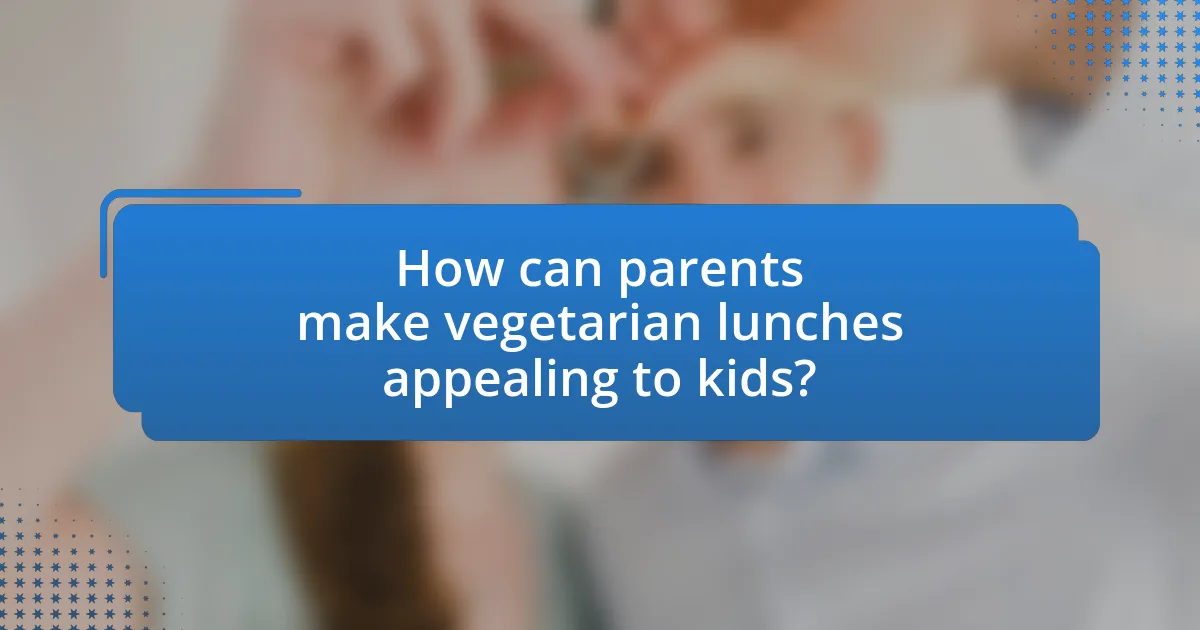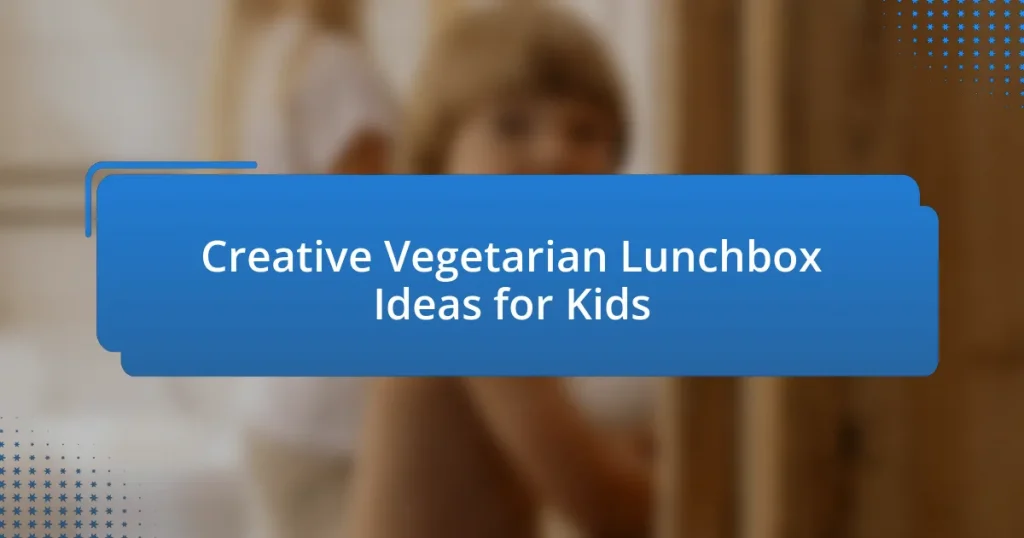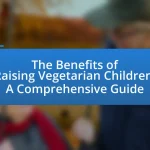Creative vegetarian lunchbox ideas for kids encompass a variety of nutritious and appealing meal options, such as vegetable sushi rolls, hummus with veggie sticks, and quinoa salad with beans. These meals not only provide essential nutrients necessary for children’s growth and development but also promote healthy eating habits. The article addresses the importance of including vegetarian options in kids’ lunches, dispels common misconceptions about their nutritional adequacy, and offers practical tips for parents on how to create balanced, visually appealing meals. Additionally, it highlights the role of presentation and involvement in meal preparation to foster a positive attitude towards vegetarian foods among children.

What are Creative Vegetarian Lunchbox Ideas for Kids?
Creative vegetarian lunchbox ideas for kids include options like vegetable sushi rolls, hummus and veggie sticks, and quinoa salad with beans. These meals are not only nutritious but also appealing to children, making them more likely to enjoy their lunch. For instance, vegetable sushi rolls can be made with cucumber, avocado, and carrots wrapped in rice and seaweed, providing a fun and interactive eating experience. Hummus paired with colorful vegetable sticks offers a tasty dip that encourages kids to eat their veggies. Quinoa salad, rich in protein and fiber, can be mixed with black beans, corn, and diced bell peppers, creating a vibrant and filling meal. These ideas promote healthy eating habits while keeping lunchtime exciting for kids.
Why is it important to include vegetarian options in kids’ lunchboxes?
Including vegetarian options in kids’ lunchboxes is important because they provide essential nutrients and promote healthy eating habits. Vegetarian meals are often rich in vitamins, minerals, and fiber, which are crucial for children’s growth and development. Research indicates that diets high in plant-based foods can reduce the risk of chronic diseases, such as obesity and diabetes, in children. Furthermore, incorporating vegetarian options can encourage children to explore diverse flavors and textures, fostering a more adventurous palate. This exposure can lead to lifelong healthy eating patterns, as studies show that early dietary habits significantly influence future food choices.
What nutritional benefits do vegetarian meals provide for children?
Vegetarian meals provide essential nutritional benefits for children, including adequate protein, vitamins, and minerals necessary for growth and development. These meals are rich in plant-based proteins from sources like legumes, nuts, and whole grains, which support muscle development and overall health. Additionally, vegetarian diets are often high in dietary fiber, promoting healthy digestion and preventing constipation.
Furthermore, vegetarian meals are abundant in vitamins such as vitamin C from fruits and vegetables, which boosts the immune system, and vitamin A from leafy greens, which is crucial for vision and skin health. Minerals like iron and calcium are also present in plant-based foods, supporting blood health and bone development. Research indicates that children who consume a balanced vegetarian diet can meet their nutritional needs effectively, as long as they include a variety of food sources to cover all essential nutrients.
How can vegetarian meals support a child’s growth and development?
Vegetarian meals can support a child’s growth and development by providing essential nutrients such as protein, vitamins, and minerals necessary for physical and cognitive development. These meals often include a variety of fruits, vegetables, whole grains, legumes, nuts, and seeds, which are rich in nutrients like iron, calcium, and vitamins A and C. For instance, legumes are a great source of protein and iron, which are crucial for muscle development and energy levels. Additionally, a study published in the Journal of the American Dietetic Association found that well-planned vegetarian diets can meet the nutritional needs of children and promote healthy growth patterns. This evidence supports the idea that vegetarian meals can be both nutritious and beneficial for a child’s overall development.
What are some common misconceptions about vegetarian lunches for kids?
Common misconceptions about vegetarian lunches for kids include the belief that they lack sufficient protein, are unappealing, and are nutritionally inadequate. Many people assume that vegetarian meals cannot provide enough protein, but plant-based sources like beans, lentils, and tofu offer ample protein content. Additionally, some think vegetarian lunches are bland or uninteresting; however, creative combinations of fruits, vegetables, grains, and legumes can make meals vibrant and enjoyable. Lastly, the notion that vegetarian diets are nutritionally deficient is incorrect, as a well-planned vegetarian lunch can meet all dietary needs, providing essential vitamins and minerals, as supported by the Academy of Nutrition and Dietetics, which states that appropriately planned vegetarian diets are healthful and nutritionally adequate for all life stages.
Why do some parents hesitate to pack vegetarian lunches?
Some parents hesitate to pack vegetarian lunches due to concerns about nutritional adequacy. They worry that vegetarian meals may lack essential nutrients such as protein, iron, and vitamin B12, which are commonly found in meat. Research indicates that children require a balanced diet for proper growth and development, and parents may fear that vegetarian options will not meet these dietary needs. Additionally, some parents may be uncertain about how to prepare appealing vegetarian meals that their children will enjoy, leading to hesitation in choosing this option for lunch.
How can these misconceptions be addressed effectively?
Misconceptions about vegetarian diets for kids can be effectively addressed through education and practical demonstrations. Educating parents and children about the nutritional benefits of vegetarian meals, such as high fiber, vitamins, and minerals, can dispel myths regarding protein deficiency. For instance, studies show that plant-based proteins from sources like beans, lentils, and quinoa can meet children’s protein needs. Additionally, providing hands-on cooking classes or workshops can help families experience the variety and taste of vegetarian options, reinforcing the idea that vegetarian meals can be both enjoyable and nutritious.

What are some easy and fun vegetarian lunchbox ideas for kids?
Easy and fun vegetarian lunchbox ideas for kids include colorful vegetable wraps, mini veggie pizzas, and fruit and nut butter sandwiches. Vegetable wraps can be made using whole grain tortillas filled with hummus, shredded carrots, cucumber slices, and bell peppers, providing essential nutrients and appealing colors. Mini veggie pizzas can be created using whole grain English muffins topped with tomato sauce, cheese, and assorted vegetables like mushrooms and spinach, making them both tasty and visually appealing. Fruit and nut butter sandwiches, made with whole grain bread, offer a sweet and satisfying option, combining the health benefits of fruits like bananas or apples with protein-rich nut butter. These ideas are not only nutritious but also encourage kids to enjoy a variety of flavors and textures in their meals.
How can parents create balanced vegetarian meals for lunchboxes?
Parents can create balanced vegetarian meals for lunchboxes by incorporating a variety of food groups, including whole grains, proteins, fruits, and vegetables. For example, using whole grain bread for sandwiches, adding hummus or nut butter for protein, and including a mix of colorful vegetables and fruits ensures nutritional diversity. Research indicates that a balanced diet rich in plant-based foods can provide essential nutrients such as fiber, vitamins, and minerals, which are crucial for children’s growth and development. By planning meals that include these components, parents can effectively support their children’s health while offering appealing and satisfying lunch options.
What are some examples of protein-rich vegetarian foods?
Examples of protein-rich vegetarian foods include lentils, chickpeas, quinoa, tofu, tempeh, edamame, Greek yogurt, and cottage cheese. Lentils provide approximately 18 grams of protein per cooked cup, while chickpeas offer about 15 grams per cooked cup. Quinoa contains around 8 grams of protein per cooked cup and is a complete protein source. Tofu and tempeh, derived from soybeans, provide 20 grams and 31 grams of protein per cup, respectively. Edamame, young soybeans, contain about 17 grams of protein per cooked cup. Greek yogurt has around 10 grams of protein per 100 grams, and cottage cheese offers approximately 11 grams of protein per 100 grams. These foods are excellent options for incorporating protein into vegetarian meals.
How can fruits and vegetables be incorporated creatively?
Fruits and vegetables can be incorporated creatively by using them as colorful, fun shapes and engaging presentations in meals. For example, cutting fruits into star or heart shapes using cookie cutters can make them visually appealing, while arranging vegetables into animal or flower designs can encourage children to eat them. Research indicates that visually appealing food can increase children’s willingness to try new foods, as highlighted in a study published in the journal “Appetite” by authors such as Birch and Fisher, which found that attractive food presentation significantly influences children’s food choices.
What are some themed vegetarian lunchbox ideas?
Themed vegetarian lunchbox ideas include a “Rainbow Lunchbox,” featuring colorful fruits and vegetables like bell peppers, carrots, and berries, which appeal to children and promote healthy eating. Another idea is a “Mediterranean Lunchbox,” consisting of hummus, pita bread, olives, and cherry tomatoes, providing a variety of flavors and textures. A “DIY Pizza Lunchbox” can include whole grain pita, marinara sauce, cheese, and assorted toppings like mushrooms and spinach, allowing kids to customize their meal. Lastly, a “Taco Lunchbox” can feature black beans, corn, avocado, and salsa, offering a fun and interactive way to enjoy a nutritious meal. These themes not only make lunch visually appealing but also encourage kids to try new foods.
How can a “Rainbow Lunch” be created with vegetarian options?
A “Rainbow Lunch” can be created with vegetarian options by incorporating a variety of colorful fruits and vegetables that represent the colors of the rainbow. For example, include red cherry tomatoes, orange bell peppers, yellow corn, green cucumber slices, blue blueberries, and purple grapes. This approach not only makes the lunch visually appealing but also ensures a range of nutrients, as different colors often indicate different vitamins and minerals. Research shows that a diet rich in colorful fruits and vegetables can improve overall health and well-being, making this lunch both fun and nutritious.
What are some “Around the World” vegetarian lunch ideas?
Some “Around the World” vegetarian lunch ideas include Mediterranean falafel wraps, Indian chickpea curry with rice, Mexican bean and cheese quesadillas, and Japanese vegetable sushi rolls. These dishes represent diverse global cuisines while being vegetarian-friendly. For example, falafel is made from ground chickpeas and is a staple in Middle Eastern cuisine, providing protein and fiber. Indian chickpea curry, known as chana masala, is rich in spices and nutrients, making it a flavorful option. Mexican quesadillas can be filled with beans, cheese, and vegetables, offering a satisfying meal. Japanese sushi rolls can be filled with avocado, cucumber, and carrots, showcasing fresh ingredients. Each of these options not only highlights different culinary traditions but also ensures a nutritious and enjoyable lunch for kids.

How can parents make vegetarian lunches appealing to kids?
Parents can make vegetarian lunches appealing to kids by incorporating colorful, fun presentations and familiar flavors. Using vibrant fruits and vegetables, such as bell peppers, carrots, and berries, can attract children’s attention and encourage them to try new foods. Additionally, creating shapes with cookie cutters or arranging food into fun designs can enhance visual appeal. Research indicates that children are more likely to eat foods that are visually appealing and presented in an engaging manner. Furthermore, including dips like hummus or yogurt can make vegetables more enticing, as kids often enjoy interactive eating experiences.
What role does presentation play in kids’ lunchboxes?
Presentation plays a crucial role in kids’ lunchboxes by influencing their willingness to eat and enjoy their meals. When food is visually appealing, children are more likely to be excited about their lunch, which can lead to better eating habits. Research indicates that colorful and creatively arranged food can enhance children’s appetite and interest in trying new foods. For instance, a study published in the journal “Appetite” found that children are more inclined to eat fruits and vegetables when they are presented in fun shapes or vibrant colors. This demonstrates that effective presentation not only makes meals more attractive but also encourages healthier eating choices among kids.
How can fun shapes and colors enhance the appeal of vegetarian meals?
Fun shapes and colors can significantly enhance the appeal of vegetarian meals by making them visually stimulating and engaging for children. Research indicates that children are more likely to eat foods that are presented in fun shapes and vibrant colors, as these elements can trigger curiosity and excitement about the meal. For instance, a study published in the journal “Appetite” found that children showed a preference for fruits and vegetables that were cut into fun shapes compared to those presented in standard forms. This visual appeal can lead to increased consumption of healthy vegetarian options, promoting better nutrition among kids.
What are some creative packaging ideas for vegetarian lunches?
Creative packaging ideas for vegetarian lunches include using bento boxes, mason jars, and reusable silicone bags. Bento boxes allow for compartmentalization, keeping different food items separate and visually appealing, which can encourage kids to try various vegetables and grains. Mason jars are excellent for salads or layered meals, as they keep ingredients fresh and can be easily transported. Reusable silicone bags are versatile and eco-friendly, providing a flexible option for snacks or sandwiches while reducing waste. These packaging methods not only enhance the presentation of vegetarian lunches but also promote healthy eating habits among children.
How can parents involve kids in the lunch preparation process?
Parents can involve kids in the lunch preparation process by assigning age-appropriate tasks such as washing vegetables, measuring ingredients, or assembling sandwiches. This hands-on participation not only teaches children essential cooking skills but also fosters a sense of responsibility and creativity in meal planning. Research indicates that children who engage in cooking activities are more likely to try new foods and develop healthier eating habits, as highlighted in a study published in the Journal of Nutrition Education and Behavior.
What are some age-appropriate tasks for kids in meal prep?
Age-appropriate tasks for kids in meal prep include washing vegetables, measuring ingredients, stirring mixtures, and assembling sandwiches. For example, children aged 2-4 can wash fruits and vegetables under supervision, while kids aged 5-7 can measure out ingredients using cups and spoons. Children aged 8-10 can assist in stirring and mixing ingredients, and those aged 11 and older can take on more complex tasks like chopping soft vegetables with a safe knife. These tasks not only engage children in the cooking process but also help develop their motor skills and understanding of nutrition.
How can involving kids foster a positive attitude towards vegetarian meals?
Involving kids in the preparation of vegetarian meals fosters a positive attitude by increasing their engagement and ownership of the food they eat. When children participate in selecting ingredients, cooking, and presenting meals, they are more likely to develop a sense of curiosity and appreciation for the flavors and textures of vegetarian options. Research indicates that children who are involved in meal preparation are more likely to try new foods and express a preference for healthier options, as evidenced by a study published in the Journal of Nutrition Education and Behavior, which found that children who helped prepare meals were more willing to taste and enjoy those meals. This hands-on experience not only enhances their culinary skills but also promotes a positive relationship with food, making vegetarian meals more appealing and enjoyable.
What are some practical tips for packing vegetarian lunches?
To pack vegetarian lunches effectively, focus on variety, nutrition, and convenience. Incorporate a mix of whole grains, proteins, and colorful vegetables to ensure balanced meals. For example, use quinoa or brown rice as a base, add chickpeas or lentils for protein, and include a selection of raw or roasted vegetables. Utilize reusable containers to keep items fresh and organized, and consider including dips like hummus or yogurt for added flavor and nutrition. Research indicates that colorful meals are more appealing to children, which can encourage them to eat healthier options.
How can parents ensure food stays fresh until lunchtime?
Parents can ensure food stays fresh until lunchtime by using insulated lunchboxes and including ice packs. Insulated lunchboxes maintain a stable temperature, keeping perishable items like fruits, vegetables, and dairy products cool. Ice packs further enhance this effect by absorbing heat, which helps prevent bacterial growth in food. Research indicates that keeping food at or below 40°F significantly reduces the risk of foodborne illnesses, making these methods effective for maintaining food safety and freshness.
What are some common mistakes to avoid when packing vegetarian lunches?
Common mistakes to avoid when packing vegetarian lunches include neglecting protein sources, failing to include a variety of colors and textures, and not considering food safety. Neglecting protein can lead to inadequate nutrition; for instance, incorporating beans, nuts, or tofu can provide essential amino acids. A lack of variety may result in unappealing meals, as colorful and textured foods enhance visual appeal and taste, making them more enjoyable for kids. Additionally, not considering food safety, such as packing perishable items without ice packs, can lead to spoilage and health risks.


